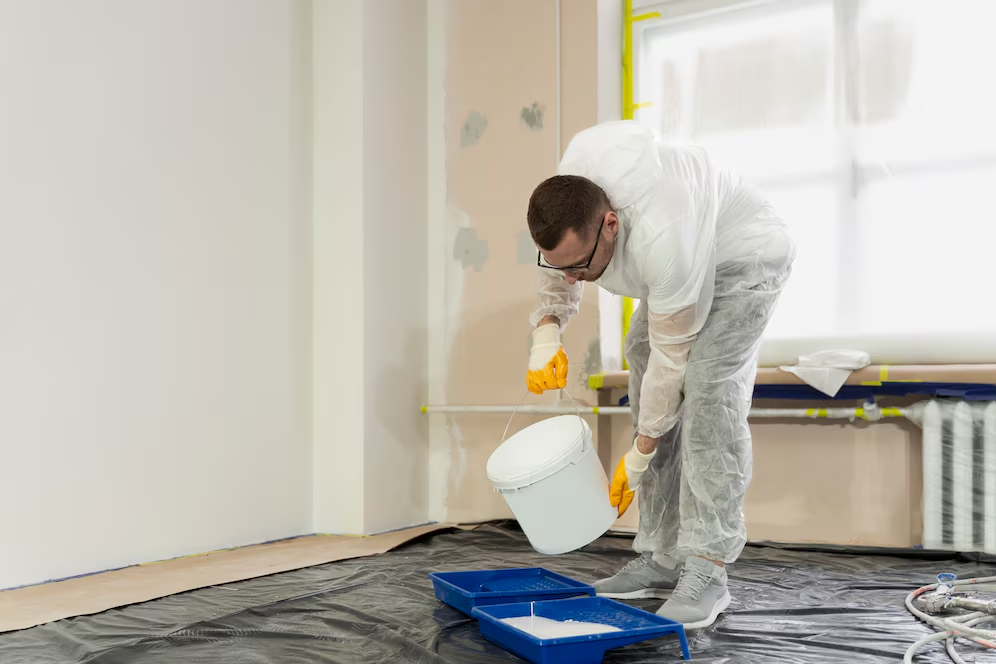A fresh coat of paint can transform any space, but the emotional tone and overall aesthetic of a room often come down to one crucial choice: color temperature. Whether planning a renovation, revamping a single room, or selecting palettes for an entire home, choosing between warm and cool tones plays a defining role. When working with a professional painting service like Precision Painting, understanding this distinction becomes easier and more impactful for your project’s success.

What are Warm and Cool Colors?
Color temperature refers to the perceived warmth or coolness of a hue. Warm colors include shades like red, orange, yellow, and brown—tones reminiscent of sunshine, fire, and earth. These colors tend to energize spaces, making them feel inviting and lively. Cool colors, such as blue, green, and purple, evoke water, sky, and foliage, giving rooms a calming and soothing effect.
Psychological Influence of Color Temperatures
The emotional impact of color should not be underestimated in interior painting. It influences how people feel and function in a space.
Warm Colors
-
Boost energy
-
Encourage conversation
-
Enhance appetite (especially in dining areas)
-
Create a cozy, intimate environment
Cool Colors
-
Promote relaxation
-
Inspire focus and clarity
-
Make a space feel larger and airier
-
Reduce visual noise in busy environments
These effects make warm and cool colors more than a matter of taste—they’re functional tools in design.
Room-by-Room Suggestions
Living Room
A gathering space benefits from a welcoming tone. Warm neutrals like beige, soft terracotta, or muted golds bring in just the right amount of energy. Accent walls in deeper warm hues like burnt sienna or paprika can ground a spacious living area.
Bedroom
Cool shades reign supreme in bedrooms. Blue-grays, sage greens, and muted purples support sleep and relaxation. Pair them with soft whites or off-whites for added balance.
Kitchen
Warm tones in the kitchen encourage appetite and togetherness. Think buttery yellows, olive greens, or peachy creams. They bring a sense of comfort, making the kitchen feel like the heart of the home.
Bathroom
Bathrooms benefit from cooler tones that provide a sense of cleanliness and calm. Aqua blues, seafoam, and misty gray-greens create a spa-like feel.
Home Office
Cool colors like slate blue, mint, or even deep charcoal help sharpen focus and maintain mental clarity. For offices doubling as creative spaces, introducing a warm accent can stimulate imagination.
Natural Light and Color Temperature
Lighting is one of the most critical aspects to consider when choosing between warm and cool colors. Natural light changes throughout the day, affecting how paint appears on the wall.
-
North-facing rooms: Typically cooler and dimmer, these benefit from warm tones to offset the chill.
-
South-facing rooms: Receive warm light, which intensifies warm colors. Cool colors help balance it out.
-
East-facing rooms: Get morning light, which is warm and soft. Warm or neutral tones are ideal.
-
West-facing rooms: Receive harsh evening light, so both warm and cool colors can be used, depending on purpose and décor.
Pairing Warm and Cool Colors
You don’t have to choose one temperature exclusively. Thoughtfully combining warm and cool colors adds depth and interest to a space. The key is balance and restraint.
Here are a few pairing ideas that work:
-
Soft blue walls with warm wood accents and terracotta textiles
-
Warm gray walls with cool navy trim and pale yellow lighting
-
Cool mint cabinetry with a warm cream ceiling and copper hardware
Strategic use of color pairings can result in sophisticated and balanced interiors without overwhelming the eye.
Flooring, Furnishings, and Fixtures
Paint doesn’t exist in a vacuum. Warm and cool tones in your walls should coordinate with other design elements like floors, furniture, lighting, and decorative accents.
Warm Paint Combos:
-
Walnut flooring
-
Brass hardware
-
Creamy upholstery
Cool Paint Combos:
-
Gray or whitewashed floors
-
Chrome or brushed nickel fixtures
-
Glass or metal furniture
Choosing finishes and furnishings with similar undertones to your paint creates cohesion throughout the room.
Color Zoning for Function and Flow
Larger, open-plan homes often benefit from subtle zoning, where color defines function without adding walls. Warm tones can anchor communal zones, while cooler tones differentiate work or private areas.
-
Use a warm, earthy tone for living/dining transitions
-
Cool greens for bedrooms or study corners
-
Combine both to create movement without confusion
This technique improves flow while maintaining a visually unified palette.
Mistakes to Avoid When Choosing Warm or Cool Paints
Even seasoned decorators make occasional missteps. Here’s a short list to help avoid the most common pitfalls:
Don’t:
-
Rely solely on online swatches—always test on your actual wall
-
Ignore undertones in existing elements like floors or countertops
-
Overload a space with multiple color temperatures
-
Assume that a light color is always cool or a dark one is always warm
-
Skip considering the direction and quality of light
Testing samples in natural and artificial lighting at different times of day is one of the best ways to prevent surprises.
Texture and Finish Matter
The same color can behave differently depending on the paint finish used. Matte finishes tend to soften and diffuse color, while gloss and satin finishes reflect more light and may amplify undertones.
- Warm Colors + Matte Finish = Cozy, rustic
- Cool Colors + Satin Finish = Clean, modern
- Mid-Sheen Neutrals = Transitional, ideal for mixed palettes
This layer of nuance adds richness to your design scheme when paired with either warm or cool palettes.
Using Neutrals to Anchor Temperature
Neutrals like white, beige, gray, and taupe can lean warm or cool, depending on undertones. They serve as a buffer when blending warm and cool elements.
- Warm Neutrals: Cream, almond, greige with yellow undertones
- Cool Neutrals: Charcoal, icy gray, pale taupe with blue undertones
Using neutrals smartly lets you shift between warm and cool color temperatures throughout a home without clashing.
Top 8 Warm and Cool Colors for Interior Walls
Warm Colors:
-
Terracotta
-
Burnt orange
-
Buttercream yellow
-
Cinnamon
-
Beige with red undertones
-
Peach
-
Rust
-
Warm taupe
Cool Colors:
-
Slate blue
-
Sage green
-
Lavender
-
Seafoam
-
Steel gray
-
Soft aqua
-
Icy mint
-
Dusty lilac
These shades are consistently favored by interior design professionals and can be modified in saturation to suit both bold and subtle aesthetics.
Trend-Proofing Your Palette
While trends come and go, color temperature remains a timeless design principle. To create a lasting interior, focus less on “color of the year” trends and more on the emotional and spatial requirements of each room. A good painting service helps prioritize longevity and practicality over fleeting fashion.
Choose colors that support how the room is used, the time spent in it, and how the light behaves throughout the day. That way, the room remains fresh and functional regardless of changing design preferences.
The Importance of Testing Paint in Your Space
Even the perfect warm or cool tone on a swatch may behave differently on your wall. Testing is a step that shouldn’t be skipped.
-
Paint two coats on a large foam board or directly on the wall
-
Move it around to different walls and observe it throughout the day
-
Compare it against furniture, lighting, and flooring
-
View it in both daylight and artificial light
This approach makes sure the chosen color interacts as intended with your environment.
Why Choose Precision Painting?
At Precision Painting, we understand how color temperature affects mood, spatial perception, and functionality. Our professional painting service combines careful color consultation with expert craftsmanship to bring your interior vision to life. Whether you’re leaning toward warm hues for a cozy retreat or cool tones for a fresh, airy feel, we ensure flawless execution and lasting beauty across every space we paint.

